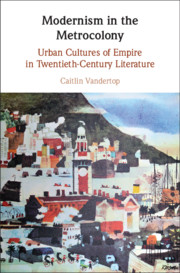
-
Select format
-
- Publisher:
- Cambridge University Press
- Publication date:
- November 2020
- November 2020
- ISBN:
- 9781108891127
- 9781108835626
- Dimensions:
- (228 x 152 mm)
- Weight & Pages:
- 0.45kg, 212 Pages
- Dimensions:
- Weight & Pages:
You may already have access via personal or institutional login
Book description
While literary modernism is often associated with Euro-American metropolises such as London, Paris or New York, this book considers the place of the colonial city in modernist fiction. From the streets of Dublin to the shop-houses of Singapore, and from the botanical gardens of Bombay to the suburbs of Suva, the monumental landscapes of British colonial cities aimed to reinforce empire's universalising claims, yet these spaces also contradicted and resisted the impositions of an idealised English culture. Inspired by the uneven landscapes of the urban British empire, a group of twentieth-century writers transformed the visual incongruities and anachronisms on display in the city streets into sources of critique and formal innovation. Showing how these writers responded to empire's metrocolonial complexities and built legacies, Modernism in the Metrocolony traces an alternative, peripheral history of the modernist city.
Reviews
‘A welcome antidote to the myths of progress that have long persuaded us to like modernity more than we should.’
Beci Carver Source: Times Literary Supplement
Contents
Metrics
Altmetric attention score
Full text views
Full text views help Loading metrics...
Loading metrics...
* Views captured on Cambridge Core between #date#. This data will be updated every 24 hours.
Usage data cannot currently be displayed.
Accessibility standard: Unknown
Why this information is here
This section outlines the accessibility features of this content - including support for screen readers, full keyboard navigation and high-contrast display options. This may not be relevant for you.
Accessibility Information
Accessibility compliance for the PDF of this book is currently unknown and may be updated in the future.


